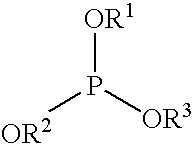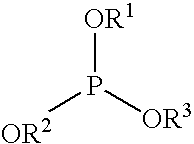Peroxide reduction in functionalized vegetable oils
a technology of functional vegetable oils and peroxide, which is applied in the direction of fatty acid oxidation, fatty oil/fats refining, fatty oil/acid recovery from waste, etc. it can solve the problems of residual peroxide and peroxide derived radicals that may unavoidably remain in the finished epoxidized vegetable oil, and the process of making the final product to be particularly susceptible to hydroperoxide formation in vegetable oils, etc., to achieve excellent reduction of peroxide levels
- Summary
- Abstract
- Description
- Claims
- Application Information
AI Technical Summary
Benefits of technology
Problems solved by technology
Method used
Image
Examples
working examples
[0042]This experimental section demonstrates specific methods and compositions which reduce the peroxide value (PV) of both epoxidized and unepoxidized vegetable oils. The oils were treated with small amounts of several types of triester phosphites. In some experiments the samples were just mixed at various temperatures and then allowed to stand. In others, they were heated under vacuum. The phosphite treatments significantly reduced the PV's of the oil and in some cases reduced material with an initial PV greater than 15 meq / kg to below 1 meq / kg (essentially zero). The phosphite treatment also improves the stability at high temperatures.
[0043]Experimental Methods
[0044]One hundred gram batches of epoxidized soybean oil (ESO) were treated with various amounts of phosphites and mixed for 30 minutes after gently warming between 140° F. and 160° F. Once mixed, the effects on the peroxide content were determined. The peroxide content was run using AOCS Method Cd 8b-90 and reported as the...
PUM
| Property | Measurement | Unit |
|---|---|---|
| Percent by mass | aaaaa | aaaaa |
| Percent by mass | aaaaa | aaaaa |
| Mass | aaaaa | aaaaa |
Abstract
Description
Claims
Application Information
 Login to View More
Login to View More - R&D
- Intellectual Property
- Life Sciences
- Materials
- Tech Scout
- Unparalleled Data Quality
- Higher Quality Content
- 60% Fewer Hallucinations
Browse by: Latest US Patents, China's latest patents, Technical Efficacy Thesaurus, Application Domain, Technology Topic, Popular Technical Reports.
© 2025 PatSnap. All rights reserved.Legal|Privacy policy|Modern Slavery Act Transparency Statement|Sitemap|About US| Contact US: help@patsnap.com



